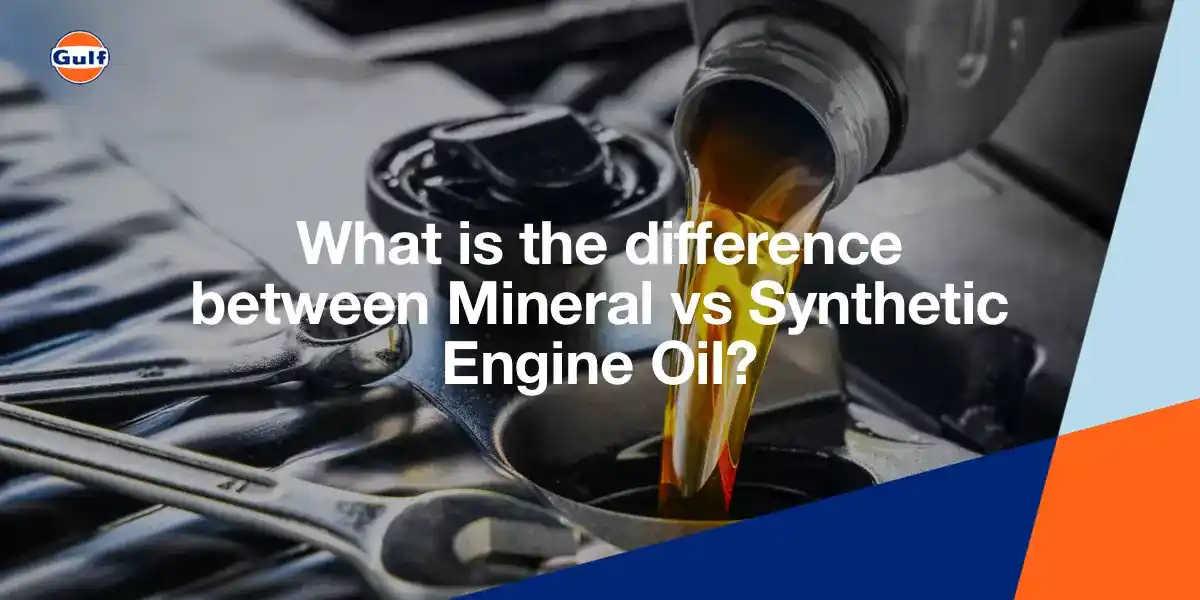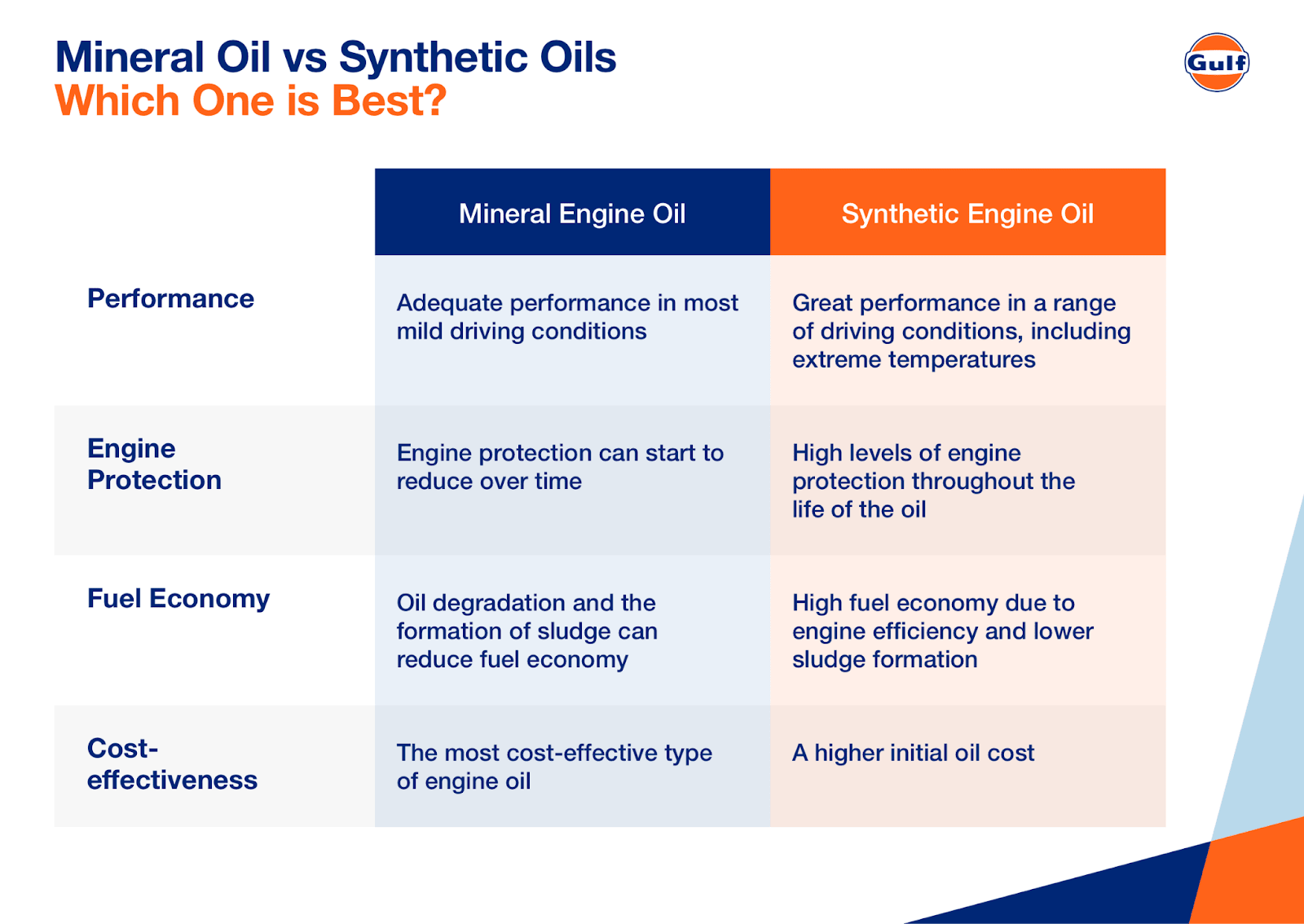What is the difference between Mineral vs Synthetic Engine Oil?
07 Feb 2025

Using an effective engine oil is an essential part of running a vehicle, as it lubricates engine parts and decreases friction, which helps reduce excessive wear and tear and keeps things running as they should. Using oil that does not meet your engine's specifications can lead to suboptimal performance, increased oil consumption, or accelerated wear over time.
To avoid these issues, it’s important to follow your vehicle’s user manual and adhere to the Original Equipment Manufacturer (OEM) specifications for engine oil type and viscosity. OEM recommendations are based on extensive testing to ensure the oil meets the specific needs of your engine, whether it’s mineral or synthetic oil.
In this blog post, we compare and contrast mineral and synthetic engine oil to help you choose the best option for your vehicle.
What is Mineral Engine Oil?
Mineral engine oil is derived directly from refining crude oil. It undergoes a basic refining process to remove impurities and prepare it for use as a lubricant.
Mineral oils are a cost-effective option and are commonly used in older engines and certain operating conditions, such as high-temperature climates or heavy-duty applications. However, they may require more frequent changes as they tend to degrade faster than synthetic oils.
Key Characteristics of Mineral Engine Oil
Mineral engine oil has some distinct properties, which include:
- Viscosity: Viscosity describes how thick or thin the oil is, affecting how well it flows to lubricate engine parts. The thickness of oil changes with temperature, which is where the viscosity index (VI) rating comes in. The VI rating indicates how stable the oil’s viscosity remains at different temperatures, usually measured at 40°C and 100°C. Traditional mineral engine oils have a VI between 95-100, but this can be higher if the oil is more refined.
- Pour point: This is the temperature at which the oil becomes too thick to flow properly, which means it won't be effective at lubricating engine parts. While mineral engine oils typically have higher pour points than synthetic oils, formulations with additives can improve their performance in colder temperatures.
- Oxidation stability: This is how likely an engine oil is to oxidise and start to break down when used over time at higher temperatures. Mineral engine oil has a lower oxidation stability than most synthetic engine oils.
- Thermal stability: This refers to how well engine oil holds up to high heat during long trips. Mineral engine oil doesn’t handle heat as well as many synthetic oils, so it can become less effective over time.
The Advantages and Disadvantages of Mineral Oil
The benefits of mineral engine oil include:
- High compatibility with older vehicles
- Can be a great option for low-mileage vehicles
- Can be a good choice if predominantly driving in mild conditions
- Available at a lower cost than most synthetic engine oils.
The disadvantages of mineral engine oil include:
- The oil may need to be topped up and changed more frequently
- It provides less protection against wear and tear in the engine
- There is a higher risk of sludge forming.
What is Synthetic Engine Oil?
Synthetic oil is formulated using advanced refining and chemical processes to produce highly stable and pure base oils from crude oil or other petroleum-based materials. The composition and production methods vary between manufacturers. The different types of synthetic base oils used in lubricants include:
1) Polyalphaolefins (PAO) oil: Known for its uniform molecular structure, PAO oil provides excellent performance across a wide temperature range and high oxidative stability.
2) Ester-based oil: Offers enhanced lubricity and superior thermal stability, making it suitable for high-performance applications.
3) Group III oil: A highly refined mineral base oil classified as synthetic due to its improved purity and performance characteristics. Often used in fully synthetic and semi-synthetic formulations.
4) Group II oil (in semi-synthetic blends): A highly refined mineral oil that offers good oxidation resistance and is commonly blended with Group III oils in semi-synthetic lubricants for balanced performance and affordability.
Both synthetic and semi-synthetic engine oils often combine different types of base oils, such as Group II and Group III, to deliver a balance of performance, durability, and cost-effectiveness for various driving conditions.
Key Characteristics of Synthetic Engine Oil
Synthetic engine oil has several important properties, which include:
- Viscosity: A higher and more stable VI than standard mineral engine oils, which means it performs consistently under a range of varying temperatures.
- Pour point: A lower pour point than mineral engine oils, which means it flows more easily and effectively in colder weather.
- Oxidation and thermal stability: Lower oxidation and higher thermal stability than mineral engine oil.
- Formation of sludge: Reduced sludge formation in synthetic engine oil when compared to mineral engine oil.
The Advantages and Disadvantages of Synthetic Engine Oil
The benefits of synthetic engine oil when directly compared to mineral engine oil, include:
- Improved engine performance
- A longer interval between oil changes
- Good protection against wear and tear of engine components
- Enhanced fuel economy because of better engine efficiency
- Suitable for high-performance vehicles which place high demand on the engine
- Suitable for driving in more extreme temperature conditions.
The disadvantages of using synthetic engine oil include:
- A higher initial cost for the oil, although it should be noted that this is offset by less frequent oil changes usually being required.
- The potential incompatibility with some older vehicles.
Fully Synthetic Oil vs Semi Synthetic Engine Oil
It’s not just a straight choice between mineral or synthetic engine oil, as synthetic oils come in two main types: fully synthetic and semi-synthetic. To know which one is best for your needs, it’s useful to compare semi-synthetic engine oil vs fully synthetic oil.
The main difference between fully synthetic oil and semi-synthetic oil is:
- Fully synthetic oil is composed entirely of synthetic base oils, which are created in a laboratory through chemical processes.
- Semi-synthetic engine oil is a blend between mineral base oils and synthetic base oils.
Semi-synthetic engine oil offers improved performance and protection compared to traditional mineral engine oil and usually costs less than fully synthetic oil. However, semi-synthetic engine oil doesn’t offer the same level of performance as fully synthetic oil, and may need to be changed more often.
Mineral Oil vs Synthetic Oils: Understanding the Difference

Conclusion
If you’re unsure whether to opt for mineral or synthetic engine oil, it’s a good idea to look at the main differences between the two and apply this to your own situation and vehicle, but always go by the recommendations in your vehicles manual.
Mineral oil generally costs less to buy and might be more suitable if you drive an older vehicle and live in a mild climate, but will need changing more often and on balance it offers lower performance and less engine protection over time.
Synthetic oil generally costs more to buy initially, but is compatible with most newer vehicles and should need to be changed less often than mineral oil. It also offers high performance levels and good engine protection, especially in demanding driving conditions.
By understanding the differences between mineral and synthetic engine oils, you can make an informed choice about what is best for your circumstances, to help protect your vehicle’s engine and improve performance.
Find out more about our engine oils.

